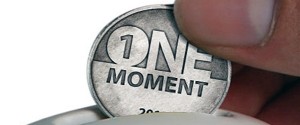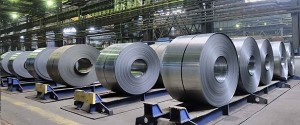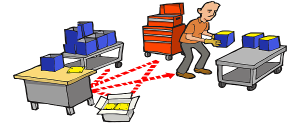
Transportation is the backbone of our economy, but it is also a fundament waste to be eliminated. As important as it is to get a product to the customer, transportation does not add value to the product. This can be easily seen. Imagine you are in a store looking for product and find two identical products on the shelf. One was transported from a factory 500 miles away, and the other was produced 5000 miles away. Would you be willing to pay more for the product that had been transported farther? Of course not. For many products, particularly perishable products like food, long transportation times can actually reduce the value of the product.
Transportation can also occur within a facility. When materials are moved around a factory, they are not gaining value, but resources are expended to move the materials. This is an easy waste to identify.
Although it may be impossible to eliminate all transportation costs, this should be the goal. Otherwise, companies will grow complacent and accepting of transportation costs.
Causes of Transportation
The majority of transportation costs are generated by moving raw materials to a factory and moving finished goods to a customer. The cause of this transportation is the centralized production of a product, and the design of the supply chain supporting production. In most industries, large scale centralized production is the norm. The result is a product that may be produced hundreds or thousands of miles away from where it is needed. The supply chain has a big effect on transportation. Sourcing raw materials locally can reduce transportation costs. When making sourcing decisions, the transportation costs are typically included in the total cost of the material being acquired.
Inside a facility, transportation is caused by wait time and inventory. Every break in a process that causes wait time has the potential to allow WIP to accumulate. As WIP accumulates, it needs to be stored, and in turn, transported to and from storage locations. With high finished goods and raw material inventories, transportation costs also raise. The bigger the warehouse, the higher the transportation costs expended in the warehouse.
In office environments, there are still significant transportation costs. In this situation, the transportation is typically of workers and not products. Many companies recognize the transportation costs of employees traveling. Whether driving or flying, it is expensive to send a person on a trip. Transportation costs also occur inside a facility. If sales and production planning need to meet regularly, but are on opposite sides of a production facility, employees will end up walking back and forth a lot.
Effects of Transportation
Transportation costs money, in equipment, fuel and labor. Transportation also drives up lead times. This is most commonly felt with imported raw materials. A component from China can take weeks to arrive, and the company must either increase inventories or increase customer lead times to accommodate the transportation time.
Transportation also drives up other costs. Every time a material is moved, there is a potential for damage. Securing a product for transportation also requires labor, as the product must be stacked and packed to minimize damage. For products shipped outside a facility, theft and security costs are also a factor.
In office environments, transportation can slow communication and cooperation. Employees working in separate locations typically do not build strong relationships. Even inside a facility, employees who are far away will be consulted less. The barrier created by distance then slows communication of critical information and the ability for organizations to develop consensus.
Solutions for Transportation
In a perfect world, there would be no transportation and everything would happen where it is needed. Manufacturing operations would be located near customers. This may seem unrealistic, but some industries are set up with local manufacturing by necessity. Every restaurant is a make-to-order manufacturing facility located as close to customers as possible. In this case, a hot hamburger fresh of the grill loses substantial value if it is packed in a box and shipped across the country. Companies strive to develop supply chains that minimize transportation (and other costs).
When implementing lean in a facility, any effort that streamlines a process should reduce transportation. Combining operations and eliminating a wait step will reduce WIP and the handling of that WIP. Reducing lead times will reduce the amount of inventory held, and reduce the transportation of that inventory to and from storage locations. The biggest steps a company can make are likely to be the development of process lines that transform raw materials into finished goods without any intermediate stops, along with a make-to-order scheduling system. In this case, raw materials are the only items that need to be stored. Once production starts, the only transportation inside the facility is the movement of material from the production line to the shipping trailer.
In an office environment, there are opportunities to reduce transportation costs. These start with technologies such as video conferencing and document collaboration tools. Designing an office around the processes within the company is also important. Most companies organize employees by function, with all the purchasing people in one area, engineering in another, production planning somewhere else, and sales in another location. Reorganizing this into cross-functional groups can speed information flow, improve collaboration and reduce transportation costs.




